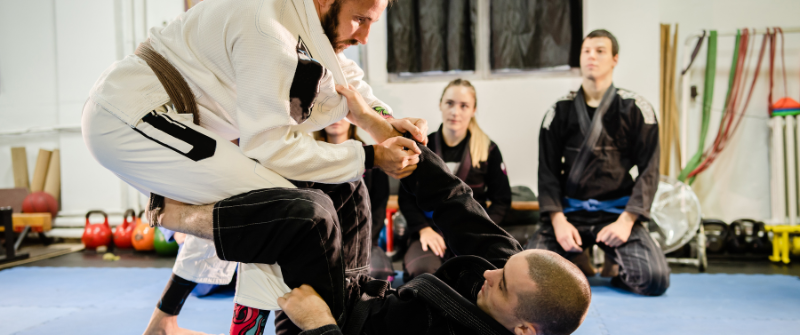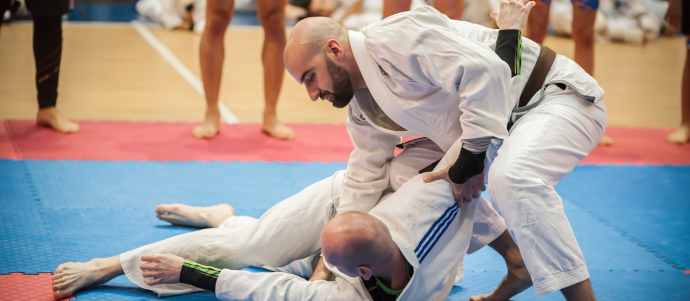
- by NEXO Team
- March 11, 2024
When it comes to owning a thriving Brazilian Jiu-Jitsu gym, the importance of having a robust and thoughtful Jiu-Jitsu gym marketing plan set in place can never be overstated. It serves as a blueprint for the gym’s success, guiding every aspect of its operations, from marketing to financial management. A well-crafted plan outlines the business concept and mission and identifies the target market, competitive advantage, and financial projections.
In this article, we’ll break down the six key provisions of a solid Brazilian Jiu-Jitsu gym marketing plan essential for a solid foundation for sustainable growth.
1. Executive Summary
The executive summary is the anchor for a BJJ gym’s marketing plan, as it offers a condensed but informative glimpse into its overarching vision. It starts by painting a picture of the business concept, followed by the mission and vision statement. A gym’s vision statement should encapsulate its commitment to empowering its members through BJJ, and the vision statement should outline the broader goals, envisioning a space where people from all backgrounds come together to grow and excel.
Beyond these principles, the executive summary also provides insights into the gym’s services, target market, competitive advantage, and financial landscape. It should serve as a strategic compass for BJJ gym owners and offer them a roadmap to attract potential investors or lenders.
2. Business Description
In crafting the business description section of your Brazilian Jiu-Jitsu gym’s marketing plan, it’s essential to provide a holistic view that encapsulates why you’re embarking on starting this business. Begin by vividly depicting your gym, including its location, facilities, and equipment. Describe the ambiance and amenities that will help set your space apart and create an inviting environment for members of all levels.
Next, break down the array of services you plan to offer, such as specific classes, personal training, and seminars to enhance overall wellness. By illustrating the depth of your offerings, you demonstrate your commitment to meeting the needs of your BJJ gym’s clientele.
You’ll also want to use this section to provide an overview of your target market, highlighting your ideal customers' demographics and psychographics. Take the time to understand their preferences, challenges, and aspirations, and tailor the gym’s offerings to suit them better.
Finally, provide information about the legal structure of your business, whether it’s a sole proprietorship, partnership, LLC, or another entity, along with ownership details. This section will not only set the stage for your gym’s operations. Still, it can also instill confidence in potential investors or lenders by showcasing your business acumen and attention to detail.
3. Market Analysis
When crafting the market analysis for your Jiu-Jitsu gym’s marketing plan, it’s important to look through the industry landscape with clarity and insight. Start by analyzing the Jiu-Jitsu industry, and take the time to explore trends, growth potential, and key players who are shaping the market. Understand all the dynamics at play and try to anticipate future developments to position your gym strategically.
Next, dive into your target market. By understanding its size and characteristics deeper, you can tailor your offerings to better resonate with their preferences. From there, conduct a comprehensive competitive analysis to identify both direct and indirect competitors, along with their respective strengths and weaknesses, and perform a SWOT analysis specific to your BJJ gym, highlighting internal strengths and weaknesses and external opportunities and threats. Taking this holistic approach to analyzing the market ensures that your gym’s marketing plan is grounded through proper research, which helps you lay a solid foundation for success.
4. Marketing and Sales Strategy
Putting together a robust marketing and sales strategy section is a key part of your Brazilian Jiu-Jitsu gym’s marketing plan, as it highlights your approach to attracting and retaining customers. Start by outlining the Jiu-Jitsu gym marketing objectives and strategies tailored to effectively reach your target market, and include branding and positioning strategies that resonate with your audience while setting your gym apart in the competitive landscape. Make sure to detail your promotional tactics, like advertising, social media strategies, events, and strategic partnerships, to help amplify the BJJ gym’s visibility.
You should also use this section to articulate your sales strategy and include pricing models, membership structures, and package options designed to appeal to various customer segments. Customer retention and referral programs can foster loyalty and expand your gym’s reach organically, so outlining your plan for implementing these into your Jiu-Jitsu gym’s marketing strategy will be important as well. By weaving together all of these elements, your marketing and sales strategy will serve as a roadmap for driving growth and success for your gym.
5. Operations and Management
The operations and management section of your BJJ gym’s marketing plan is vital to ensure everything functions smoothly and efficiently at all levels. Start by defining your organizational structure and delineating roles and responsibilities to help instill clarity and accountability among your team members. Then, develop a comprehensive staffing plan that aligns with your gym’s vision and outline qualifications and training requirements to cultivate a skilled and motivated workforce.
Next, you’ll want to detail operating procedures for classes, scheduling, and facility management, as this will help streamline the day-to-day operations and enhance the customer experience. Be sure to prioritize health and safety measures in this process and include robust emergency protocols to safeguard the BJJ gym’s staff and members. Finally, start integrating systems and technologies, such as scheduling software and secure payment systems, to optimize operational efficiency and enhance customer service.
6. Financial Plan
When mapping out the financial plan for the BJJ gym’s business strategy, you’re charting the course for financial success and sustainability. Begin this process by defining the gym’s revenue model and incorporating a thoughtful pricing strategy aligned with market demand and value proposition alongside projected sales estimates. Make sure you’re considering startup costs, including equipment, renovations, and initial Brazilian Jiu-Jitsu gym insurance and marketing expenses, as this will lay the groundwork for a strong financial foundation.
Developing a sales forecast will also help you anticipate revenue growth over the first few years, and you can complement this with a break-even analysis to better pinpoint when profitability is expected. Use this section to present comprehensive financial projections, including income statements, cash flow statements, and balance sheets for the initial three to five years, as this will serve as a roadmap for financial health and growth and detail funding requirements and potential sources of financing.
Lastly, include an exit strategy. Consider all potential avenues for exiting or selling the business, as this ensures a forward-thinking approach to long-term financial planning for your BJJ gym.
Conclusion
Each provision outlined in the Jiu-Jitsu gym marketing plan is crucial in steering the business toward success. From the executive summary to the financial plan, every section contributes towards the comprehensive roadmap that helps guide the company through its inception, growth, and potential exit. By meticulously detailing these key provisions, BJJ entrepreneurs can attract potential investors or lenders and create a path toward profitability and success in the competitive world of Jiu-Jitsu gyms.
Categories
Fill out a short form to contact us with your questions or to receive a customized quote.
Recent Posts
-
 Is Your Pilates Studio Prepared for a Medical Emergency?
January 5, 2026
Is Your Pilates Studio Prepared for a Medical Emergency?
January 5, 2026 -
 NEXO’s Affinity Program: How Fitness Suppliers and Associations Can Partner for Profit and Protection
December 5, 2025
NEXO’s Affinity Program: How Fitness Suppliers and Associations Can Partner for Profit and Protection
December 5, 2025 -
%20(1).png) How to Insure an MMA Gym Without Paying for Coverage You Don’t Need
December 5, 2025
How to Insure an MMA Gym Without Paying for Coverage You Don’t Need
December 5, 2025 -
 Mastering Liability for Jiu-Jitsu Tournaments and Martial Arts Events
December 5, 2025
Mastering Liability for Jiu-Jitsu Tournaments and Martial Arts Events
December 5, 2025 -
 From Zen to Zoning: What Every Yoga and Pilates Studio Owner Should Know Before Signing a Lease
December 5, 2025
From Zen to Zoning: What Every Yoga and Pilates Studio Owner Should Know Before Signing a Lease
December 5, 2025

